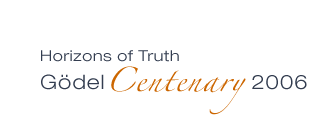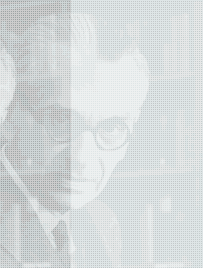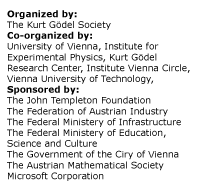Exihibition: Gödels Jahrhundert - Gödel's Century
The exhibition is now online at http://www.goedelexhibition.at/
Throughout the symposium, there will be an exhibition on Gödel by Karl Sigmund and John W. Dawson.
The exhibition will be opened during the Opening Ceremony on 26 April. Till 6 May it will be shown in the Kleiner Lesesaal of the University of Vienna, Monday to Friday 9-21, Saturday 9-12.
The same exhibition will later be shown in the Palais Palffy, from 15 May to 15 June, and in the Museumsquartier, Ovalhalle, from 11 July to 6 August.
As an appetiser Karl Sigmund allowed us to make a preprint of his article in the Notices of the AMS available as PDF document.
Furthermore, photos from the exhibition can be found here.
The invitation folder is also available as PDF document.
Here is a press text:
Time Magazine ranked him among the hundred most important persons of the twentieth century. Harvard University made him a honorary doctor "for the discovery of the most significant mathematical truth of the century." He is generally viewed as the greatest logician since Aristotle. His friend Einstein liked to say that he only went to the institute to have the privilege of walking back home with Kurt Gödel. And John von Neumann, one of the fathers of the computer, wrote: "Indeed Gödel is absolutely irreplaceable. He is the only mathematician about whom I dare make this assertion."
Kurt Gödel (1906-1978), who was born in Brno, studied in Vienna during the `twenties. At the age of twenty-four, he revolutionized not only mathematics, but also the way we see it. During the `thirties, he commuted between Vienna (where he earned, as a private lecturer, 2.90 shillings per semester) and Princeton (he was one of the first guest members of the newly-founded Institute for Advanced Study). In early 1940, he emigrated to the USA (although not racially persecuted) via the Soviet Union and Japan. He never returned to Vienna, and wrote to his mother that he was plagued by nightmares about being trapped in Vienna again.
But Gödel had spent his best and most productive years in Vienna. He belongs to the Vienna between the wars, just like Sigmund Freud, Ludwig Wittgenstein, Karl Popper, Konrad Lorenz, Robert Musil or Arnold Schönberg, and he may well one day be considered as the best-known representative of this uniquely rich "golden autumn". Vienna honors him, belatedly but gratefully, by a large congress held at the University of Vienna, sponsored by the Templeton Foundation, and an exhibition under the patronage of the Austrian president, financed by the state and the city.
Gödel proved that every mathematical theory rich enough to allow for counting, adding and multiplying contains true statements which cannot be proved, except if the theory harbours a contradiction. Worse yet, if one can prove that the theory is consistent, then it is not. As Hans Magnus Enzensberger wrote in his Hommage ā Gödel: "You can describe your own language in your own language: but not completely". This statement seems reasonable enough, but Gödel managed to translate it into a mathematical proposition. He succeeded in turning a philosophical sentence into a mathematical theorem. In this sense, what Gödel has done for philosophy is similar to what Newton has done for physics.
The two other big discoveries of Gödel are of a similar breath-taking temerity. He made a fundamental contribution to set theory, the science of infinity, a field that has been called "the theology of mathematicians". Gödel succeeded in solving one half of the so-called continuum hypothesis, the number one on the hit-list of mathematical problems of his century. And he proved that Einstein's theory of relativity permits, on principle, to travel into one's own past, something that cosmologists, to this day, have not properly digested. Gödel remarks, in an aside, that the direction of time, after landing in one's own past, is the same as before. Hence time does not run in the opposite sense, like a film spooling backward.
Gödel, who analysed proofs for the existence of God, who believed in metempsychosis and who wanted to uncover a conspiracy against Leibniz seems hardly to fit into the twentieth century. But he spent his life right in the center of the avant garde of its time. Both the thinkers of the Vienna Circle and the scientists in Princeton belonged to the most modern minds the twentieth century had to offer. Thus for instance, the development of the computer by Alan Turing and John von Neumann is based on mathematical logic and formal systems, fields whose undisputed champion was Gödel, in those years. The incompleteness theorem, discovered by Gödel well before the time of programmable computers, is a theorem on the limitations of computer programs, and since the success of "Gödel-Escher-Bach", Gödel ranks as an icon of the computer age.
Duration of the exhibition: 26.04 - 06.05. Lesesaal der Uni Wien 15.05 - 15.06 Palais Palffy 11.07- 07.08 Ovalhalle Museumsquartier
The exhibition is NOT directed at experts but at all those interested in cultural history. The curators of the exhibition are the mathematicians Karl Sigmund and John Dawson.A large part of the material stems from the archives of the University of Vienna and the Firestone Library in Princeton, and much as never been shown before. Hans Magnus Enzensberger wrote an introduction to the catalogue of the exhibition.





 Print this page
Print this page